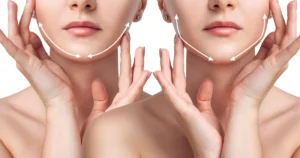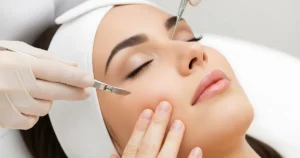Dermaplaning is a popular beauty treatment involving a surgical scalpel to remove the top layer of dead skin cells and vellus hair. Even though dermaplaning is known for making the skin feel and look better, there is a persistent myth that it makes hair grow back thicker.
This article will bust this myth and explain how dermaplaning can help hair grow. We’ll also talk about the benefits of dermaplaning for hair growth so you can decide if it’s the proper treatment for you.
Discover it today with us here at Ella Medical Aesthetics. Check out more details in this post now.
How Does Dermaplaning Work
Dermaplaning works with a surgical scalpel to remove dead skin cells and vellus hair from the top layer of skin. It’s a non-invasive procedure that aestheticians often do, and it works for all skin types.
In dermaplaning, a surgical scalpel gently scrapes the skin at a 45-degree angle. This helps to get rid of dead skin cells and vellus hair. This can make the skin look more radiant and smooth.
Does Dermaplaning Grow Your Hair Thicker?
The idea that dermaplaning can make hair grow back thicker has stuck around for a long time. But this is not the case. Dermaplaning has nothing to do with hair growth. After dermaplaning, the hair that grows back will have the same texture and thickness.
The myth may have started because the hair removed during the treatment is often vellus, which is thin and hard to see. When it grows back, it may look thicker. But this is just a trick; the hair won’t get thicker.
To better understand, the hair that grows back will have the same texture and thickness. The truth is dermaplaning is a non-invasive procedure meant to exfoliate the skin and remove vellus hair, making the skin look smoother and more radiant.
Vellus Hair vs. Terminal Hair
It’s important to know that vellus hair differs from terminal hair, which grows on your head, underarms, and other parts of your body. Vellus hair is much thinner and shorter than terminal hair, and it doesn’t have a medulla, which is the innermost part of the hair shaft.
Because of this, vellus hair is much less evident than terminal hair, which doesn’t change how the skin looks. Also, no research has shown that dermaplaning makes hair grow back thicker.
Many dermatologists and aestheticians recommend Dermaplaning as a safe and effective way to eliminate dead skin cells and vellus hair on the face. By removing these layers of dead skin and peach fuzz, the skin can absorb skincare products better and look smoother and healthier.
In short, dermaplaning does not make hair grow back thicker. If you want to try dermaplaning, look for a trustworthy service provider to help you reach your beauty goals. But how does the treatment make your hair grow? Let’s see below.
How Dermaplaning Can Help Hair Grow
Even though dermaplaning doesn’t make hair thicker when it grows back, it can help hair grow in other ways. Here are some ways that dermaplaning can help hair grow:
- Dead Skin Cell Removal: Dermaplaning helps remove dead skin cells, which can block hair follicles and stop hair growth.
- Better Blood Flow: Dermaplaning can help improve blood flow to the skin, which can help nourish hair follicles and speed up hair growth.
- Stimulating Hair Follicles: Dermaplaning can stimulate hair follicles, which can help hair grow.
- Improved Absorption: Dermaplaning can help hair growth products be absorbed better, so they can get deeper into the skin and work better on the hair follicles.
With all these matters, Dermaplaning can make your skin look smoother and healthier, boosting your confidence and making you feel better.
Other Ways To Keep Your Hair Growing
Aside from Dermaplaning, there are other ways it can help hair grow. If you want to try dermaplaning to help your hair grow, find a good provider who has done the treatment before.
At Ella Medical Aesthetics, we offer safe and effective dermaplaning treatments that can help improve your skin’s texture and look while encouraging hair growth. Contact us right away to set up a meeting and find out more about how we can help you reach your beauty goals.
We offer various other beauty services besides dermaplaning, such as Chemical peels, Kybella, and Fillers. We have the knowledge and tools to help you get the desired results if you wish to get rid of fine lines and wrinkles or improve the texture and tone of your skin.
Is The Treatment Safe?
Dermaplaning doesn’t involve surgery, so it’s safe to say it is. It is also not a laser treatment or a chemical peel. It is just a simple way to eliminate dead skin cells that licensed estheticians and doctors.
Dermaplaning is not the same as microdermabrasion, which is a type of skin resurfacing. Instead, it is a way to get rid of dead skin cells on the top layer of your skin without using chemicals or lasers.
How Often Should You Have Dermaplaning?
It’s best to wait at least a month between dermaplaning sessions if you have sensitive skin. The same goes for people with acne who want to avoid worsening skin.
But if your skin has a lot of hair, this process might not work. Some experts say you should only do it once every three months, and even then, only if there aren’t any other problems (such as sensitive skin).
Consult With Us Today!
Dermplaning can eliminate two to four weeks of dead skin you couldn’t see. It is also a significant extra step before other skin care treatments because it makes it easier for the products to get into the skin.
After your appointment, you can see the smooth and bright results. Every four weeks, treatment can be done! At Ella Medical Aesthetics, we will carefully examine your skin to see if dermaplaning is the best treatment. Book an appointment today and see how we can help!







